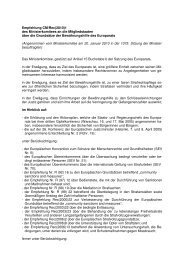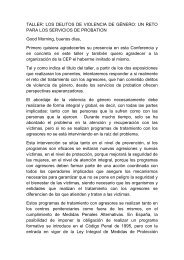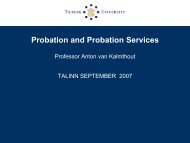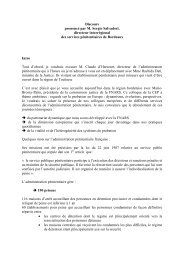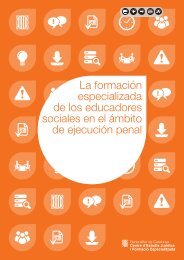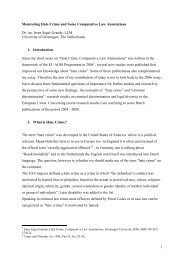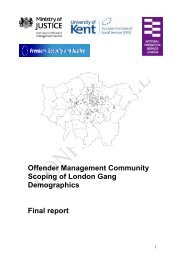Psychological Treatment of Incarcerated Sex Offenders
Psychological Treatment of Incarcerated Sex Offenders
Psychological Treatment of Incarcerated Sex Offenders
Create successful ePaper yourself
Turn your PDF publications into a flip-book with our unique Google optimized e-Paper software.
<strong>Psychological</strong> <strong>Treatment</strong> <strong>of</strong><br />
<strong>Incarcerated</strong> <strong>Sex</strong> <strong>Offenders</strong><br />
Óscar Herrero<br />
Secretaría General de Instituciones<br />
Penitenciarias<br />
Spain
<strong>Psychological</strong> <strong>Treatment</strong> <strong>of</strong><br />
<strong>Incarcerated</strong> <strong>Sex</strong> <strong>Offenders</strong><br />
• Why sex <strong>of</strong>fenders should be treated?<br />
• Which are the therapeutic targets?<br />
• The Program for the Control <strong>of</strong> <strong>Sex</strong>ual<br />
Assault: Structure and Characteristics.<br />
• Evaluation and results
SEXUAL OFFENCES 31/01/11<br />
121<br />
19<br />
763<br />
SEXUAL ASSAULT<br />
SEXUAL ABUSE<br />
SEXUAL STALKING<br />
EXHIBICIONSM AND OTHER NON<br />
CONTACT OFFENCES<br />
2095<br />
SEXUAL<br />
ASSAULT<br />
SEXUAL<br />
ABUSE<br />
SEXUAL<br />
STALKING<br />
EXHIB. AND OTHER<br />
NON CONTAC<br />
MALE 2086 754 121 19<br />
FEMALES 9 9 0 0<br />
TOTAL 2095 763 121 19
What is <strong>Sex</strong> Offender treatment?<br />
• In general terms:<br />
– <strong>Psychological</strong> intervention.<br />
– Delivered in group.<br />
– Cognitive-behavioral.<br />
– Seeks to induce positive changes.<br />
– Decrease re<strong>of</strong>fending.
Outcome Evaluations<br />
Meta-analysis <strong>Treatment</strong> Change in recidivism<br />
Reitzel & Carbonell,<br />
2006<br />
Gallagher et al. 1999<br />
Hanson et al. 2002<br />
Young sex <strong>of</strong>fenders -46%<br />
Adult and young sex<br />
<strong>of</strong>fenders<br />
Adult and young sex<br />
<strong>of</strong>fenders<br />
-36%<br />
-28%<br />
Lösel & Schmucker,<br />
2005<br />
Adult and young sex<br />
<strong>of</strong>fenders<br />
-24%<br />
Hall 1995<br />
Adult and young sex<br />
<strong>of</strong>fenders<br />
-24%
Outcome Evaluations<br />
Meta-analysis <strong>Treatment</strong> Change in recidivism<br />
Aos et al 2001 Young sex <strong>of</strong>fenders -12%<br />
Aos et al 2001 Adult sex <strong>of</strong>fender -10%<br />
Schmucker & Lösel,<br />
2008<br />
Young and adult sex<br />
<strong>of</strong>fenders<br />
-37%
Redondo & Garrido, 2008<br />
Therapeutic<br />
Gain 5-10%<br />
80%<br />
untreated no<br />
recidivist<br />
10-15% High<br />
Risk <strong>Offenders</strong><br />
20% untreated<br />
recidivist
Risk factors (I)<br />
Family<br />
Background<br />
•History <strong>of</strong><br />
child abuse.<br />
•Aggressive<br />
behaviour.<br />
•Insecure<br />
attachment<br />
style.<br />
<strong>Sex</strong>ual<br />
Behaviours<br />
•Early sexual<br />
interest<br />
•Impersonal sexual<br />
life<br />
•<strong>Sex</strong>ual<br />
preocupation<br />
•Deviant sexual<br />
arousal<br />
Cognitions<br />
•Cognitive<br />
distortions<br />
•Deviant sexual<br />
fantasies<br />
•Low IQ
Risk Factors (II)<br />
Emotions<br />
•Negative<br />
emotions<br />
•Lonelyness and<br />
inadequacy<br />
feelings.<br />
•Emotional<br />
poverty<br />
•Empathy deficits<br />
Lifestyle<br />
•Drugs &<br />
alcohol<br />
•Intimacy<br />
deficits<br />
•Absence <strong>of</strong><br />
regular habits<br />
Personality<br />
traits<br />
•Impulsivity<br />
•Antisocial<br />
traits
Static risk factors are<br />
unmodificable characteristics <strong>of</strong><br />
the individual<br />
Dynamic risk factors (i.e.<br />
criminogenic needs) tend to be<br />
stable but are amenable to change
The <strong>Sex</strong>ual Aggression Control<br />
Program
General Characteristics<br />
• Group therapy.<br />
• Voluntary.<br />
• Relapse prevention.<br />
• Long and intensive.<br />
• High commitment.<br />
• Non-pathological conceptualization <strong>of</strong> the<br />
<strong>of</strong>fender.<br />
• Oriented to self-control.<br />
• Oriented to the community.
Between 2006 and 2010, 810<br />
inmates have participated in the<br />
sex <strong>of</strong>fender program.<br />
The program is delivered in 33<br />
prisons.
The main therapeutic goal is to<br />
reduce re<strong>of</strong>fence rates among the<br />
treated <strong>of</strong>fenders<br />
This goal is reached through<br />
intermediate therapeutic goals
Therapeutic Goals<br />
• Increase empathy levels.<br />
• Reduce cognitive distortions.<br />
• Help the <strong>of</strong>fender to understand his<br />
own process <strong>of</strong> re<strong>of</strong>fence.<br />
• Training in coping strategies.<br />
• Decrease deviant sexual drive and<br />
fantasies.
Inclusion Criteria<br />
• Sentenced inmates.<br />
• <strong>Sex</strong>ual <strong>of</strong>fence (adult or child victims).<br />
• About two years away from conditional<br />
release.<br />
• Without major mental disorders o<br />
intellectual disabilities.<br />
• Literate in Spanish.
Therapeutic Team<br />
• Psychologist.<br />
• Social Worker.<br />
• Social Education Pr<strong>of</strong>essional.<br />
• Specific training in sex <strong>of</strong>fender<br />
treatment.
Structure<br />
• Biographical Analysis.<br />
• Emotional management.<br />
• Cognitive Distortions.<br />
• Empathy Training.<br />
• Lifestyle Change.<br />
• Deviant <strong>Sex</strong>ual Arousal.<br />
• <strong>Sex</strong>ual Education.<br />
• Relapse Prevention.
Avoidance and Approach goals<br />
Avoidance <strong>of</strong> risk<br />
factors such as<br />
drug and alcohol,<br />
pornography,<br />
negative emotional<br />
states, distorted<br />
thoughts, deviant<br />
sexual stimulus,<br />
inpersonal sex.<br />
Approach to protective<br />
elements like positive<br />
and significant<br />
relationships, healthy<br />
habits, sense <strong>of</strong> mastery<br />
and control over their<br />
lives
Case Formulation<br />
• In the last phase <strong>of</strong> the program the<br />
therapist builts:<br />
– An individual explanation <strong>of</strong> the <strong>of</strong>fence<br />
process.<br />
– An individual relapse prevention plan.
Marital Rape<br />
• <strong>Sex</strong>ual coercion is a common behavior<br />
in a spousal abuse situation.<br />
• The specific Intimate Partner Violence<br />
program includes a Marital Rape unit,<br />
where these behaviors are addressed.
Evaluation<br />
• Complex Design.<br />
• Involves several groups <strong>of</strong> inmates<br />
(treated and non treated sex <strong>of</strong>fenders).<br />
• Conducted by an independent team <strong>of</strong><br />
researchers (University <strong>of</strong> Barcelona).<br />
• Pre-post self-report measures and<br />
longitudinal follow-up <strong>of</strong> re<strong>of</strong>fence<br />
rates.
The <strong>Sex</strong>ual Aggression Scale<br />
• Self-report scale designed to measure<br />
the core psychological aspects <strong>of</strong><br />
sexual <strong>of</strong>fenders.<br />
• Subscales <strong>of</strong> Empathy, Cognitive<br />
Distortions, Self-Esteem, Social<br />
Inadequacy, Self-Control and <strong>Sex</strong>ual<br />
Anxiety.
CRIMINAL<br />
CARREER<br />
INITIAL<br />
ASSESMENT<br />
POST-RELEASE<br />
FOLLOW UP<br />
PRE INTERVENTION POST<br />
BEHAVIORAL<br />
TESTS<br />
EPAS<br />
REOFFENCE RATES
Self Report results
Research Design<br />
• Pre-post design.<br />
• Experimental and control groups<br />
• Non randomized assignment<br />
• Data collected in 37 prisons.
PRE<br />
POST<br />
TG-Adult <strong>of</strong>fenders<br />
N=211<br />
TG-Adult <strong>of</strong>fenders<br />
TG-Child molesters<br />
N=133<br />
TG-Child molesters<br />
CG-Adult <strong>of</strong>fenders<br />
N=122<br />
CG-Adult <strong>of</strong>fenders<br />
CG-Child molesters<br />
N=113<br />
CG-Child molesters
Demographic Data<br />
• Mean Age: 39.<br />
• Family background <strong>of</strong> substance abuse<br />
and mental disorders: 32%<br />
• History <strong>of</strong> Child <strong>Sex</strong>ual Abuse: 10%.<br />
• History <strong>of</strong> substance abuse: 50%.<br />
• Intrafamiliar victim: 23%
PRE<br />
POST<br />
TG-Adult <strong>of</strong>fenders<br />
TG-A pre ≠ TG-A post<br />
TG-Adult <strong>of</strong>fenders<br />
TG-A pre = CG-A pre<br />
TG-A pre = TG-CH pre<br />
TG-A post = TG-CH post<br />
TG-A post ≠ CG-A post<br />
TG-Child molesters<br />
TG-CH pre ≠ TG-CH po<br />
TG-Child molesters<br />
CG-Adult <strong>of</strong>fenders<br />
CG-A pre = CG-A post<br />
CG-Adult <strong>of</strong>fenders<br />
TG-CH pre = CG-CH pre<br />
TG-CH post ≠ CG-CH post<br />
CG-Child molesters<br />
CG-CH pre = CG-CH post<br />
CG-Child molesters
Adult <strong>Offenders</strong><br />
(<strong>Treatment</strong> – Control PRE)<br />
Sig = .4
Child Abusers<br />
(<strong>Treatment</strong> – Control PRE)<br />
Sig = .3
Adult <strong>Offenders</strong><br />
(PRE-POST)<br />
Sig = .000
Child Abusers<br />
(PRE-POST)<br />
Sig = .000
Adult <strong>Offenders</strong><br />
(Control – <strong>Treatment</strong> POST)<br />
Sig = .000
Child Abusers<br />
(<strong>Treatment</strong> – Control POST)<br />
Sig = .3
Adult <strong>Sex</strong> <strong>Offenders</strong><br />
(Subscales)<br />
• Significant differences were found for:<br />
– Self-esteem.<br />
– Cognitive distortions.<br />
– Self-control.<br />
– Empathy.
Child Abusers<br />
(Subscales)<br />
• Signifficant differences were found for:<br />
– Self-esteem.<br />
– Cognitive distortions.<br />
– Loneliness feelings.
Recidivism rates in the<br />
community
<strong>Sex</strong>ual recidivism<br />
• Sample 1:<br />
– 40 treated sex <strong>of</strong>fenders<br />
– 5 years follow up in the community<br />
– 17.5% (5) <strong>of</strong> non sexual recidivism<br />
– 5% (2) <strong>of</strong> sexual recidivism
<strong>Sex</strong>ual recidivism<br />
• Sample 2:<br />
– 60 treated sex <strong>of</strong>fenders<br />
– 2 years follow up in the community<br />
– 8.4% (5) <strong>of</strong> non sexual recidivism<br />
– 5% (3) <strong>of</strong> sexual recidivism
EMPIRICAL RECIDIVISM<br />
5% Treated &<br />
recidivist High<br />
Risk<br />
<strong>Offenders</strong><br />
95% treated non recidivist
Conclusions<br />
• There is a growing empirical evidence that<br />
supports the treatment <strong>of</strong> sex <strong>of</strong>fenders.<br />
• This program is implemented in near 50% <strong>of</strong><br />
the Spanish prisons.<br />
• Initial results suggest a positive<br />
psychological change in treated samples.




![AGIS2 Nov 08 Conference Report_[Version 2] - CEP, the European ...](https://img.yumpu.com/50764570/1/190x245/agis2-nov-08-conference-report-version-2-cep-the-european-.jpg?quality=85)
